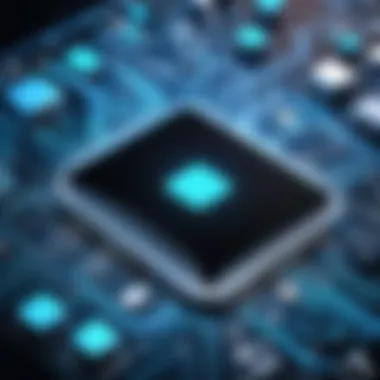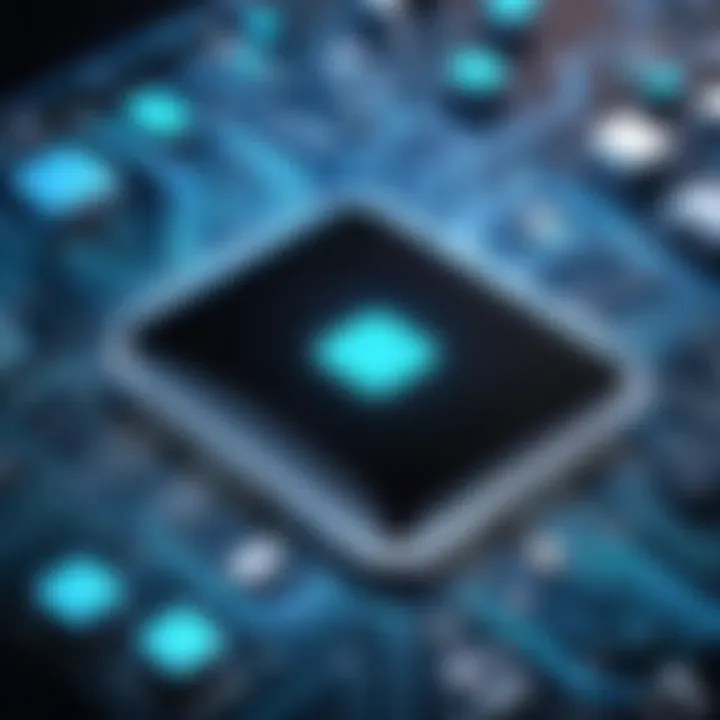Connected Devices: Navigating the Digital Landscape


Intro
As we step boldly into this era, the very fabric of our day-to-day lives is being woven together by an ever-expanding web of connected devices. From smart home gadgets that adjust the thermostat with just a whisper to wearables that track our heart rates with the precision of a seasoned doctor, these technologies are not merely novelties. Rather, they serve as vital conduits connecting our individual worlds to a broader digital landscape.
The emergence of connected devices is reshaping more than just convenience; it’s altering the essence of how we interact, work, and even think. With so many gadgets lining the shelves, it can feel like drinking from a fire hose. However, understanding this landscape is critical to actively participate in a world where connectivity is the norm rather than the exception.
In this article, we will journey through the maze of connected devices, scrutinizing their technology, applications, challenges, and opportunities. Each section aims to unravel the intricate threads that bind today’s consumers to their smart devices, offering insights that are both informative for the curious tech enthusiast and essential for anyone looking to navigate this dynamic digital world.
Preface to Connected Devices
In an era where technology intertwines with every aspect of our lives, understanding connected devices becomes essential. They are not merely gadgets; they form the backbone of what many now refer to as the Internet of Things (IoT). The significance of connected devices lies in their ability to communicate, collect, and exchange data, bringing forth a level of convenience and efficiency that was once the stuff of science fiction.
Consider a typical day: waking up to a smart alarm clock that nudges you at the perfect moment in your sleep cycle, followed by having your coffee maker start brewing just as you step into the kitchen. Such seamless integration simplifies daily routines, effortlessly motivating us to embrace a tech-enhanced lifestyle.
Defining Connected Devices
Connected devices are electronic devices that can connect to the internet or other devices, gathering and sharing data. This category includes everything from the everyday smartphone to advanced industrial machinery. To put it plainly, if it can send or receive data, it’s a connected device.
- Examples Key Components:
- Sensors and Actuators: Allow devices to interact with their environment.
- Wireless Communication Modules: Facilitate the transfer of data across networks.
These devices leverage software and hardware advancements, encompassing a broad range of items designed for various functions—from home security systems to health monitoring wearables. As we delve deeper, it's clear that these devices don't just serve one purpose; they foster interconnectivity across all segments of society.
Historical Context and Evolution
The evolution of connected devices paints a fascinating picture of human innovation. While the concept of connected devices may feel new, history shows us its roots date back several decades. The first instance of interconnected technology can be traced to networked computers in the late 1960s. It was a radical game changer, laying the groundwork for today's advanced systems.
Fast forward to the 1990s, when the term "Internet of Things" was coined, signaling a new era where everyday objects could be augmented with technology. Since then, advancements in microcontrollers, wireless communication technologies like Wi-Fi and Bluetooth, and improvements in cloud computing have propelled the connected device industry forward.
"The interconnectedness we experience today wasn't possible a generation ago because of the sheer limitation of technology. We've only scratched the surface of potential applications."
The progression has continued into the present day, where connected devices are becoming commonplace. With each leap—be it through the rise of smart homes or the expansion of wearables—our interaction with technology has transformed.
This historical view underscores the remarkable shift not only in how we interact with devices but how those devices shape our experiences.
In essence, grasping the concept of connected devices enriches our understanding of modern technology's role and its trajectory into the future.
Types of Connected Devices
Understanding the various types of connected devices is paramount in this digital age. Each category serves unique functions, enhancing our daily lives, automating tasks, or improving business efficiencies. The implications of these devices go beyond convenience; they can reshape our environments, how we communicate, and how industrial processes are managed. This section elucidates the diverse types of connected devices and their significance in the broader context of connectivity.
Consumer Electronics
Smartphones
The core functionality of smartphones goes beyond mere communication; they serve as a gateway to the digital world. Their ability to access the internet, download applications, and integrate with other connected devices makes them integral to modern life. One standout feature of smartphones is their versatility; you can use them for work, entertainment, and social networking all in one device.
Moreover, smartphones have made information readily available at our fingertips. However, the constant connectivity can lead to distractions and over-dependence on technology, making it a double-edged sword in today’s society.
Tablets and Laptops
Tablets and laptops have carved their niche by providing portability without sacrificing performance. They have become the go-to devices for both professionals and students alike. Tablets shine with their intuitive touch interfaces, making them an excellent choice for reading and multimedia consumption. Laptops, meanwhile, provide more robust computing power and a full keyboard for extensive work tasks.
The unique aspect of tablets is their lightweight nature, which allows users to carry them easily. On the flip side, their smaller screen sizes may not be ideal for in-depth analysis or multitasking. Laptops can handle heavier applications, yet their bulk can hinder mobility.
Smart TVs and Streaming Devices
Smart TVs and streaming devices have revolutionized how we consume content. With applications allowing direct access to various streaming services, users can enjoy their favorite shows without traditional cable subscriptions. Smart TVs typically come with integrated apps, while streaming devices like Roku or Amazon Fire Stick enhance even regular TVs.
An interesting feature is the voice control functionality, allowing users to browse content using simple commands. Yet, the dependency on internet connectivity may limit viewing options in case of a network failure, which can be a downside.
Home Automation Devices
Smart Thermostats
Smart thermostats can substantially reduce energy consumption while maintaining comfort. By learning user preferences and utilizing data to optimize heating and cooling schedules, these devices are valuable in energy efficiency. A notable feature is the remote access capability—users can adjust their home's temperature from anywhere via smartphones.
However, integrating them into existing systems can be a challenge, particularly in older homes with outdated heating setups.
Smart Lights and Locks
Smart lighting systems and locks offer unparalleled convenience and security. Automated lighting can be controlled remotely and often integrates with other smart home devices to enhance energy savings. Smart locks allow homeowners to manage access without traditional keys, providing features like temporary access codes.
Still, these advancements may raise concerns regarding their cybersecurity vulnerabilities. Picture this: after a long day, you want to stroll into your home with ease, but what if a hacker can unlock the door just as quickly?
Voice Assistants
Voice assistants like Amazon Alexa or Google Assistant bring a hands-free experience to managing connected devices. Their significance lies in the simplicity of voice commands, making technology accessible even to those less tech-savvy. With built-in compatibility across many devices, they serve as central hubs.
However, privacy issues can arise. Many users remain uncomfortable regarding data collection and the potential misuse of voice recordings.


Wearable Technology
Fitness Trackers
Fitness trackers like Fitbit focus on health management, promoting active lifestyles. They monitor physical activity, track sleep patterns, and even provide heart rate data. An appealing feature is the gamification aspect; many users enjoy competing against themselves or others.
However, the accuracy of tracking can vary across devices, leading to skepticism about their reliability.
Smartwatches
Smartwatches have taken wearables to another level by offering not just fitness features but also seamless integration with smartphones. They allow notifications, calls, and even mobile payments at a glance. Unique to smartwatches is their convenience; users can check vital information without diving into their pockets.
On the downside, battery life can be a limitation under heavy usage, forcing users to frequently recharge.
Health Monitors
Health monitors track various health metrics and offer real-time feedback essential for managing specific health conditions. They provide a unique service, enabling users to maintain awareness of their health status continuously. This capability is invaluable for individuals managing chronic diseases, as it encourages proactive health management.
Yet, the dependence on these monitors for something as critical as health can create undue stress, especially for the overly anxious.
Industrial IoT (Internet of Things)
Connected Machinery
Connected machinery in factories facilitates smart manufacturing processes. By collecting data from machines in real-time, businesses can optimize operations and reduce downtime. This connectedness allows for efficiency and quick responsiveness to issues as they arise.
However, incorporating this technology requires significant upfront investments, which might not be feasible for all businesses.
Supply Chain Sensors
Supply Chain Sensors have revolutionized inventory management through real-time tracking. Companies can monitor stock levels and locations, which streamlines logistics. One unique feature of these sensors includes alerts on supply shortages, allowing for immediate action.
Despite their advantages, reliance on sensors could lead to failures in the event of technical issues, which may disrupt entire operations.
Predictive Maintenance Systems
Predictive maintenance systems utilize data analytics to forecast maintenance needs before failures occur. This proactive approach not only improves operational efficiency but also extends equipment life. The ability to schedule maintenance before breakdowns happen is a game changer in industrial contexts.
Nevertheless, manufacturers must invest in advanced data analytics technology to fully harness these systems, which can create financial barriers for smaller players in the market.
Applications and Use Cases
Understanding the applications and use cases of connected devices is critical in the current digital age. It's where the rubber meets the road, demonstrating not just how these gadgets work, but how they reshape our daily lives and industries. Whether it's making our homes smarter or positioning businesses for the future, the ways connected devices integrate into society are truly transformative.
Impact on Daily Life
Convenience in Everyday Tasks
The convenience factor in everyday tasks made possible by connected devices cannot be overstated. Having the ability to control heating, lighting, and even appliances remotely brings an extraordinary level of comfort and efficiency to our lives. Imagine waking up, and with just a few taps on your smartphone, the coffee is brewing, the lights gradually brighten, and the thermostat adjusts to your preferred temperature. This seamless integration fosters a lifestyle where multitasking is the norm, allowing for more leisure time in our increasingly hectic schedules.
Moreover, devices that automate tasks, like smart vacuum cleaners or programmable coffee makers, can save us time. Although convenient, one must also consider the challenge of reliance on technology—if devices fail, it can disrupt our routines.
Enhanced Home Security
Connected devices significantly bolster home security. Smart cameras, doorbell cameras, and automated locking systems offer peace of mind like never before. With the ability to monitor your home in real time via mobile apps, homeowners can stay alert and engage with their property even when they are miles away. These systems can send alerts directly to your phone, notifying you of any unusual activity, thereby increasing the chances of preventing break-ins.
However, dependence on technology can pose risks; if security systems are hacked, it could expose your home and data to threats. Striking a balance between smart security and personal privacy becomes crucial.
Health Monitoring and Management
In the realm of health, wearable technology brings forth remarkable advancements in monitoring various health vitals. Devices like fitness trackers and smartwatches offer users real-time feedback on activities such as heart rate, sleep patterns, and physical performance. This focused attention on individual health makes health management more accessible and proactive, urging individuals to adopt healthier lifestyles based on data-rich insights.
Nevertheless, while these devices contribute immensely to personal health management, concerns about data privacy linger. Users must be wary of what health data is shared and who has access to it, making it pivotal to ensure proper settings are employed.
Business and Industry Innovations
Smart Manufacturing
Smart manufacturing embraces the Internt of Things (IoT) to enhance the production line. By incorporating connected machinery, companies can gather data in real-time, thus optimizing operations and reducing costs. One key characteristic of smart manufacturing is its ability to predict when machines need maintenance, significantly decreasing downtime and avoiding costly errors.
However, these systems require robust internet connectivity and can be expensive to implement initially. A proper assessment of long-term gains versus costs is essential to make the shift worthwhile.
Data Analytics for Business Optimization
Connected devices yield vast amounts of data, and this information is invaluable when used effectively. Businesses that harness data analytics can gain insights that tailor services to their customers' needs and preferences. With the capacity to analyze consumer behavior and market trends, organizations can improve efficiency and drive sales.
On the flip side, flooding the analysis with data can sometimes lead to analysis paralysis, where decision-making becomes convoluted by excess information. Clever, strategic thinking must accompany data usage to guarantee effectiveness.
Consumer Insights and Engagement
Consumer insights linked to connected devices are a goldmine for brands. They help companies understand customer preferences and behaviors, allowing them to curate personalized experiences. Through direct engagement via apps and feedback collection, businesses can build stronger relationships with their audience. Unique features of this approach include targeted advertising and recommendations based on individual tastes.


However, this level of personalization raises ethical quandaries around data privacy. Companies must ensure transparency to gain consumer trust and avoid backlash from data misuse.
Smart Cities Initiatives
Intelligent Transportation Systems
The integration of connected devices into transportation infrastructures gives birth to intelligent transportation systems (ITS). These systems help manage traffic flow, reduce congestion, and improve safety on the roads. By communicating with vehicles and traffic signals, ITS can optimize routes and reduce travel times.
Nevertheless, implementing these systems necessitates significant investment from local governments and can be met with resistance from those hesitant about the changes in infrastructure. Cost and public acceptance play crucial roles in the scalability of such initiatives.
Public Safety Enhancements
Public safety becomes significantly more effective through connected device applications. From surveillance cameras to gunshot detection systems, technology enhances emergency responses and surveillance. A critical benefit of this is the potential to lower crime rates and improve community safety.
Yet, there are concerns regarding surveillance overreach. Communities may feel their privacy is invaded, so it’s essential for authorities to strike a balance and establish trust with citizens.
Sustainable Urban Development
Sustainable urban development hinges on connected devices to monitor resources effectively and manage waste. Smart grids and water sensors contribute to reducing energy consumption and ensuring efficient resource usage in cities. One striking feature of such systems is their ability to provide real-time data, enabling local governments to make informed decisions.
However, as cities evolve, the environmental impact of device production and usage must not be overlooked. The journey toward embracing sustainability while managing electronic waste requires careful planning and execution.
"Connected devices are not just gadgets; they redefine our productivity, security, and quality of life, but we must navigate their implications thoughtfully."
Technological Framework
The realm of connected devices hinges significantly on the technological framework that underpins their function and efficacy. A robust framework determines how seamlessly these devices communicate, share data, and integrate with one another. Understanding this framework is crucial for unpacking the myriad of interactions that occur between devices and systems, showcasing the complexity and sophistication of today's digital landscape.
Various elements contribute to this framework, including connectivity protocols, infrastructural developments, and data management systems. As devices proliferate, the importance of these technologies only increases. They ensure that the plethora of devices works not just individually, but also collaboratively, creating an interconnected web that enhances efficiency and user experience. By dissecting these components, we unveil the nuanced dynamics that empower connected devices to function optimally while also addressing challenges.
Connectivity Protocols
Wi-Fi and Ethernet Standards
When discussing connectivity protocols, Wi-Fi and Ethernet standards stand out due to their robust capabilities. These elements govern how devices connect to the internet or to one another. For instance, the key characteristic of Wi-Fi is its ability to provide a wireless medium for connecting devices within a certain range, making it exceptionally convenient for homeowners and businesses alike. In contrast, Ethernet is often found in environments that demand stable and high-speed connections, such as data centers.
A unique feature of Wi-Fi is its versatility; it can connect multiple devices simultaneously across a wide area, which is beneficial for household use where devices can range from laptops to smart TVs. However, its disadvantage lies in potential interference, particularly in congested areas. Ethernet, on the other hand, boasts strong reliability and lower latency, serving well for activities that require consistent data speeds. Yet, its drawback includes a reliance on physical cables, which can limit flexibility in device placement.
Bluetooth and Near Field Communication
Bluetooth and Near Field Communication (NFC) play crucial roles especially in the realm of wearable technology and mobile payments. The key characteristic of Bluetooth is its capacity for short-range communication, enabling devices to connect without direct line-of-sight. This has made it an invaluable tool in social settings where sharing data is requisite, such as in fitness tracking or music sharing.
What sets NFC apart is that it allows for extremely short-range data exchange—usually within a few centimeters—making it ideal for secure transactions, like those performed with mobile wallets. The advantage of NFC lies in its ease of use and quick connection establishment, yet this also limits its application range significantly compared to Bluetooth. Thus, each technology has its niche, catering to different use cases.
Cellular Technologies like 5G
As we transition into higher bandwidth and ultra-reliable connectivity, 5G cellular technologies emerge as a game changer. The key characteristic of 5G is its unparalleled speed and capacity for low-latency communications, essential for real-time applications such as autonomous driving and smart city infrastructures. It represents a significant leap forward from previous generations, enabling a vast number of devices to connect without lag.
A unique feature of 5G is its ability to support a massive volume of devices simultaneously, crucial as the Internet of Things (IoT) expands. However, its deployment can be expensive and requires extensive infrastructure changes, which may pose challenges in certain regions. Yet, the potential benefits, ranging from increased connectivity to enhanced efficiency across sectors, warrant the investment in this shifting technological landscape.
Developing Infrastructure
Cloud Computing
Cloud computing is another cornerstone of the technological framework, pivotal for the storage and processing of data generated by connected devices. The key characteristic of cloud computing is its flexibility, allowing users to access resources and services without the need for on-premise hardware. This adaptability has made it a popular choice for businesses aiming to scale operations without incurring hefty upfront costs.
A unique aspect of cloud computing is its capacity for real-time data access, enabling teams to collaborate on projects from different locations without losing momentum. However, it is not without its challenges; reliance on cloud services raises concerns around data privacy and security, as centralizing data can become a ripe target for cyber attacks.
Edge Computing
Edge computing complements cloud solutions by processing data closer to the source, reducing latency and bandwidth use. The key characteristic of edge computing is its ability to analyze data locally, sending only relevant information to the cloud for deeper analysis. This is particularly advantageous in situations requiring immediate responses, such as in autonomous vehicles or industrial IoT applications.
A unique feature of edge computing is its capability to operate in real-time, a necessity for time-sensitive applications. The disadvantage, however, is that managing multiple edge devices increases the complexity of infrastructure requirements, necessitating more comprehensive management strategies.
Data Management Systems
Data management systems underpin the efficacy of both cloud and edge computing, facilitating efficient storage, retrieval, and analysis of data. Their key characteristic is the structure they provide, enabling organizations to make sense of the massive amounts of data generated by connected devices. Effective data management can significantly enhance decision-making processes by presenting insights drawn from relevant data sets.
What sets these systems apart is their ability to integrate with various applications, thereby increasing productivity across different sectors. Yet, challenges persist, particularly in ensuring data accuracy and consistency. As we navigate this evolving landscape, robust data management becomes increasingly crucial for leveraging the potential of connected devices effectively.
Effective connectivity, infrastructure, and data management are essential cogs in the machinery of connected devices, shaping how we interact with technology.
Security and Privacy Concerns
The presence of connected devices fundamentally alters our relationship with technology in profound ways. As these devices become ubiquitous, understanding their security and privacy implications is paramount. From the smart thermostat keeping your home cozy to the wearable fitness tracker monitoring your health, each of these devices comes with potential risks that users must navigate. Security and privacy concerns are not merely technicalities; they represent crucial aspects that can significantly impact one's personal safety and data integrity in an increasingly interconnected world.
Risks Associated with Connected Devices
Cybersecurity Threats
Cybersecurity threats loom large in the realm of connected devices. They can manifest in various forms such as malware, phishing attacks, and denial-of-service attacks. One of the key characteristics of cybersecurity threats is their adaptability. Cybercriminals constantly evolve their tactics, making it vital for users to stay vigilant.
Such threats are particularly relevant to this article, as connected devices often contain sensitive information. If, for instance, a smart home camera is hacked, this not only breaches privacy but can also expose users to significant risk.
The unique feature here is the way these threats exploit common vulnerabilities. Since many devices use default passwords or lack adequate security updates, they become prime targets for hackers. The disadvantages are pronounced—loss of personal data, financial theft, and even physical security risks.


Data Breaches
Data breaches represent a grave concern tied directly to connected devices. When personal data falls into the wrong hands, the repercussions can be dire—identity theft, unauthorized transactions, or even reputational damage. A critical characteristic of data breaches is their potential scale. For example, a breach affecting one organization can compromise millions of individual accounts.
In context, discussing data breaches is beneficial as they often highlight the need for robust data management practices within organizations that deploy connected devices. A unique aspect of data breaches is the ripple effect they can create. Once data is hacked, it usually circulates in the black market, further escalating the issue. The disadvantages are notable, as recovery can be lengthy and costly, involving legal fees and customer trust rebuilding.
Device Vulnerabilities
Device vulnerabilities often arise from poor coding practices or insufficient testing of connected devices before their release. This means that a single oversight in design can lead to significant risks. A key characteristic of these vulnerabilities is their variability. Some devices are built with strong security protocols, while others might be riddled with flaws, making them easy targets for attackers.
This topic is crucial for our discussion as it directly relates to user education; understanding that not all devices are created equal fosters more informed purchasing decisions. A unique feature of device vulnerabilities, compared to other risks, is that many can often be remedied via firmware updates or better security settings. However, if manufacturers don’t prioritize security, users are left exposed, facing the disadvantage of insecurity in their everyday technology usage.
Protective Measures and Best Practices
Implementing Strong Passwords
Strong password creation is foundational in mitigating risks associated with the use of connected devices. A significant aspect of implementing strong passwords is complexity; passwords should combine uppercase letters, digits, and symbols to enhance security. The importance of this practice lies in its ability to prevent unauthorized access to devices.
One unique feature of strong passwords is their role as the first line of defense against hacking attempts. If, for example, a user avoids common passwords such as "123456" or "password," the chances of their devices being compromised significantly decrease. The downside, however, is that strong passwords can often be difficult to remember, leading to the temptation of writing them down—this creates its own set of risks.
Regular Software Updates
Regular software updates are crucial for keeping connected devices secure. Each update typically includes patches for vulnerabilities that have been discovered since the last iteration. A defining characteristic of regular updates is their timeliness; promptly applying them can limit exposure to known threats.
In this article's context, emphasizing the need for such updates speaks directly to maintaining long-term device integrity. A unique advantage of this approach is its simplicity—automatic updates can be enabled on many devices, ensuring users remain protected with minimal effort. On the flip side, delayed updates can lead to increased risks, as outdated software becomes a hacker's playground.
Utilizing Encrypted Connections
Utilizing encrypted connections when connecting devices to the internet is essential in safeguarding data during transmission. The essence of encryption is its ability to render data unreadable to anyone who intercepts it. The characteristic of encrypted connections that stands out in this narrative is their effectiveness at enhancing privacy.
The discussion around encryption is vital, as many users are unaware of the risks associated with unencrypted networks. The unique feature of encryption technology is that it not only applies to data in transit but can also protect data at rest, depending on the implementation. The challenge is that while encryption significantly raises security levels, it can sometimes introduce latency or connection issues, demanding a careful balance by users.
Future of Connected Devices
The future of connected devices stands as a pivotal focal point in our understanding of the digital landscape. In an age where technology permeates every facet of life, grasping the direction in which these devices are heading is crucial for both consumers and developers alike. The integration of advanced technologies promises innovative solutions that can enhance our everyday experiences, reshape industries, and, ultimately, improve our quality of life.
Emerging Trends and Technologies
Artificial Intelligence Integration
Artificial intelligence (AI) is an increasingly significant aspect of connected devices. AI enhances their ability to learn from user behavior, delivering personalized experiences. For instance, smart home systems that utilize AI can adjust lighting, temperature, and even suggest meal preferences based on past interactions. This adaptive behavior makes AI a highly desirable choice for businesses seeking to boost customer satisfaction and streamline interactions.
A unique feature of AI is predictive analysis, where algorithms analyze data patterns to foresee user needs. While this can result in incredibly tailored experiences, it also raises concerns about the balance between efficiency and privacy. Users may find AI's insightful predictions astonishing, yet the collection and storage of personal data instances can feel intrusive.
Expanded Uses in Healthcare
The expanded uses of connected devices in healthcare represent one of the most promising applications of technology. Devices that monitor health statistics in real time provide invaluable insights both for patients and healthcare providers. For example, wearables that track heart rates, glucose levels, or even sleep patterns empower individuals to take control of their health. This proactivity is crucial in the fight against chronic diseases.
A notable characteristic of this application is the seamless way in which these devices communicate with medical professionals, enabling remote monitoring and timely interventions. However, this convenience comes with its own set of hurdles. Issues surrounding data accuracy and the reliability of these devices can impact trust levels among users.
Advancements in Robotics
Advancements in robotics are transforming not just consumer experience but also the landscape of industry and manufacturing. Robots integrated with connected device technology can perform tasks with astounding accuracy, from assembling products to conducting routine inspections in hazardous environments. This enhancement promises not only efficiency but also the potential for scalability in various sectors.
One of the standout features of these advancements is their capability for autonomous operation. Robots can work without human oversight, gathering and transmitting data back to a central system for analysis. The downside here is the fear that automation might supplant human jobs, raising ethical conversations about the future workforce.
Ethical Considerations
Surveillance and Privacy
The intertwining of surveillance with connected devices raises significant ethical questions. As homes grow smarter and cities become more interactive, devices equipped to monitor behavior introduce a level of scrutiny into our lives that was once unimaginable. While the promise of increased safety is appealing, this feature can evolve into an uncomfortable intrusion of privacy.
A key characteristic of surveillance technology is its pervasiveness, as it's often embedded in the very devices people rely on daily. While it offers security, it also risks normalizing the sense of being constantly observed. The potential advantages, such as crime reduction, can’t mask the concerns of individual freedom being compromised.
Data Ownership Issues
Connected devices generate vast amounts of data, and how this data is owned and utilized is becoming a point of contention. Data ownership issues revolve around whether users truly comprehend the extent of their data's collection and usage by corporations. Often, users don’t fully grasp that their information can be commodified and sold. This obscurity breeds distrust among consumers, which is both a disadvantage for businesses and a potential detriment to the technological progress.
The unique aspect of this challenge lies in the ongoing discussions surrounding user rights within digital environments. As such, it’s essential to dialogue about data ownership moving forward, advocating for transparency and user control.
Environmental Impact of Device Production
Finally, the environmental impact of device production remains a crucial topic. The rapid proliferation of connected devices results in significant e-waste, which can harm ecosystems and contribute to pollution. This sector faces the challenge of sustainability: how to innovate responsibly while minimizing environmental footprints.
A key characteristic of this discussion is circular economy practices. Promoting recycling and efficient resource usage can mitigate some negative impacts. Nevertheless, balancing the demand for the latest technology with eco-friendly practices remains an ongoing battle for tech companies and consumers alike who are becoming increasingly aware of their environmental responsibilities.
"The path forward isn't just about innovation; it's about taking the time to consider the implications of our advancements."
Culmination
As we draw the curtain on this exploration of connected devices, it is crucial to grasp the full scope of their influence in our modern world. The myriad of devices, from smartphones to smart-home systems, are interwoven into the fabric of daily life and industry alike. Understanding the implications of these technologies is more than just a passing curiosity; it encompasses significant elements that shape our privacy, security, and overall quality of life.
Recapping Key Insights
In recapping the essential points discussed throughout the article, consider the following:
- Diverse Types of Devices: Connected devices come in manifold forms, each tailored for specific purposes. From smart household items that automate mundane tasks to wearables that monitor health, the variety is staggering.
- Applications Across Sectors: The uses of connected devices extend beyond personal convenience. Industries harness their capabilities for enhanced efficiency, data collection, and predictive maintenance. This tech isn’t just about lifestyle; it invigorates entire sectors, be it healthcare or manufacturing.
- Technological Foundations: Understanding the underlying tech—like 5G connectivity and cloud computing—is fundamental for appreciating how these devices function and communicate effectively.
- Security and Privacy Challenges: The risks cannot be understated. Cybersecurity threats loom large, making it imperative for users to adopt robust protective measures to safeguard personal and sensitive data.
- Future Potential and Ethical Considerations: As we look ahead, we must weigh the advancements against ethical dilemmas, including surveillance concerns and environmental implications of device production. The conversation around tech isn't just about innovation; it's about responsibility.
This reality demands a nuanced view; connected devices are not merely conveniences, but powerful tools that necessitate thoughtful engagement.
Looking Ahead at Connectivity
Peering into the future of connectivity, it appears ripe with possibility yet fraught with challenges. Below are some focal points to anticipate:
- Interconnectivity Evolution: Future devices will likely enjoy even deeper integration and interoperability. The dream of a seamlessly connected world is inching closer, allowing all devices to communicate effortlessly, fostering an ‘IoT ecosystem’ where data flows freely across platforms.
- AI and Machine Learning: These technologies will enhance the user experience, allowing devices to learn and adapt to individual preferences. This level of personalization could revolutionize how we interact with technology on a daily basis.
- Sustainable Tech Development: As environmental concerns gain traction, the demand for eco-friendly devices that minimize waste and maximize energy efficiency will only rise. Future devices may harness renewable energies, aligning with the global push for sustainability.
- Ethical Tech Advancements: Alongside technological growth, ethical considerations will become increasingly prominent. Devices that respect user privacy and prioritize data ownership will likely emerge as essential in consumer choices.
As we stand at the threshold of a digital future, the tale of connected devices is one of promise mingled with responsibility. Curiosity and caution must guide our navigation through this digital landscape.







